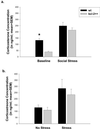Social stress exacerbates stroke outcome by suppressing Bcl-2 expression
- PMID: 11553785
- PMCID: PMC58815
- DOI: 10.1073/pnas.201215298
Social stress exacerbates stroke outcome by suppressing Bcl-2 expression
Abstract
The relationship between stressful life events and the onset of disease is well documented. However, the role of psychological stress as a risk factor for life-threatening cerebrovascular insults such as stroke remains unspecified, but could explain individual variation in stroke outcome. To discover the mechanisms through which psychological stress may alter stroke outcome, we modeled the effects of chronic social intimidation and stress on ischemia-induced bcl-2 expression and early neuronal cell loss resulting from cerebral artery occlusion in mice (C57BL/6). The bcl-2 protooncogene promotes cell survival and protects against apoptosis and cellular necrosis in numerous neurodegenerative disorders, including stroke. In our study, male mice were chronically exposed to aggressive social stimuli before induction of a controlled, mild ischemic insult. Stressed mice expressed approximately 70% less bcl-2 mRNA than unstressed mice after ischemia. In addition, social stress greatly exacerbated infarct in wild-type mice but not in transgenic mice that constitutively express increased neuronal bcl-2. Despite similar postischemic concentrations of corticosterone, the major stress hormone in mice, high corticosterone concentrations were significantly correlated with larger infarcts in wild-type mice but not bcl-2 transgenic mice. Thus, enhanced bcl-2 expression offsets the potentially deleterious consequences of high postischemic plasma corticosterone concentrations. Taken together, these data demonstrate that stressful prestroke social milieu strongly compromises an endogenous molecular mechanism of neuroprotection in injured brain and offer a new behavioral target for stroke therapy.
Figures





References
-
- Baum A, Posluszny D. Annu Rev Psychol. 1999;50:137–163. - PubMed
-
- Harmsen P, Rosengren A, Tsipogianni A, Wilhelmsen L. Stroke. 1990;21:223–229. - PubMed
-
- Carasso R, Yehuda S, Ben-uriah Y. Int J Neurosci. 1981;14:223–225. - PubMed
-
- Agewall S, Wikstrand J, Fagerberg B. Stroke. 1998;29:2329–2333. - PubMed
Publication types
MeSH terms
Substances
LinkOut - more resources
Full Text Sources
Medical

